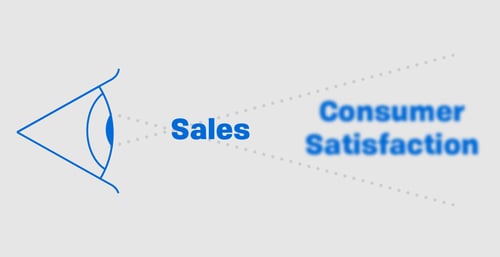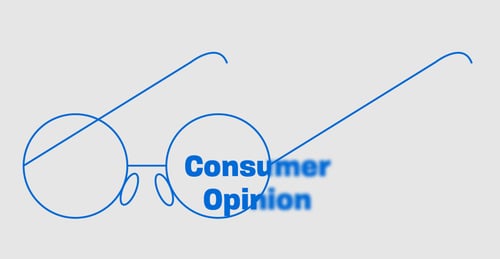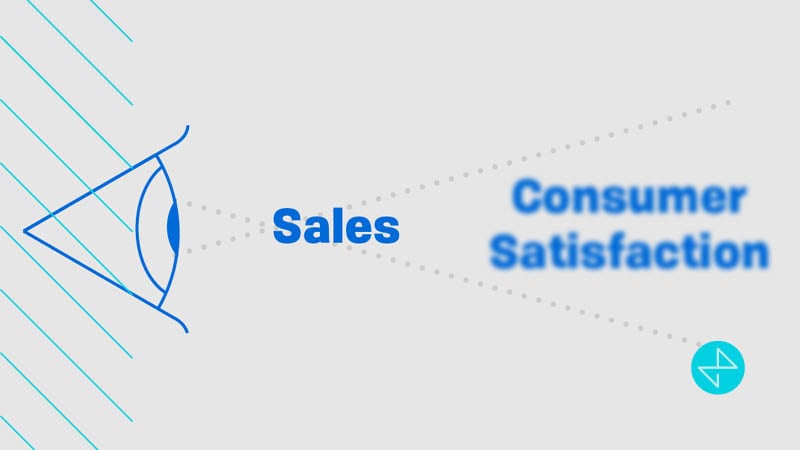What is marketing myopia?
The term "marketing myopia" was coined by Theodore Levitt in 2004 for the Harvard Business Review. Borrowing from the medical term for nearsightedness, marketing myopia refers to taking a short-sighted approach to marketing.
Just like a nearsighted person would squint to read a sign far away if they don't have glasses or contacts, a myopic marketing strategy only focuses on an immediate need for the brand instead of what is required to see for the long term.
 Once the squinting stops, the person still can't see at a distance, and they still need corrective lenses: the same is true of myopic marketing. A very immediate need is met to make a sale, but longer-term marketing and the customers' needs aren’t in their field of vision.
Once the squinting stops, the person still can't see at a distance, and they still need corrective lenses: the same is true of myopic marketing. A very immediate need is met to make a sale, but longer-term marketing and the customers' needs aren’t in their field of vision.
For instance, a haircare brand focusing solely on maintaining an image through advertising and social media presence without paying attention to the customers who actually use their products isn’t taking in the big picture. They aren’t factoring in that consumers may want different sizes, products for other hair textures, or alternative brand experiences. By focusing on just one dimension or strategy, they could be at risk of losing customers who find what they need elsewhere.
Which businesses are particularly prone to marketing myopia?
Marketing myopia can strike no matter how large or established a brand is. Small businesses could be expected to make mistakes focusing on short-term sales instead of long-term customer relationships and retention, but so do large companies.
One of the most notable examples of big business marketing myopia was when Kodak took a painfully short-sighted approach as digital cameras were becoming more common in the early 2000s. They assumed that the average consumer would keep buying film and disposable cameras and only professional photographers would go digital due to expense. Kodak didn't plan for the digitally-driven future, and ultimately lost to competitors offering cheaper digital cameras that were easy to use, while one-hour-photo services vanished from drugstores worldwide. Kodak’s failure to plan ahead constitutes a strategic myopia rather than marketing myopia, but hubris in one’s own success often plays a role either way.
With new technologies and changing industries, businesses need to stay connected with their audience and adapt their business and marketing strategies. When Uber came into the market, the ride-hailing model was able to capitalize on the fact that many people weren't loyal to a particular taxi company and were eager to try something that was more convenient and cost-effective. However, Uber was challenged early on when other ride-hailing competitors like Lyft joined the market. Throughout the years, both have had to continue to evolve their business models and marketing techniques by understanding what their customers are looking for and staying relevant through market research. This has led to both companies expanding beyond their original ridesharing to over pool rides, black car services, electric scooter rentals, and food delivery. The market still is constantly being challenged due to labor laws and new ride-hailing services marketing themselves as an elevated alternative with company-owned fleets, better security practices, and surveillance for safety.
No matter the size or the industry, businesses that fail to change with the times or get a leg up on long-term marketing strategies are the end result of marketing myopia.
When would marketing myopia pose an advantage?
- Marketing myopia doesn’t always put a brand at a total disadvantage. While it can, at times, make businesses lose sight of long-term strategy—and potentially the opportunity for forming lasting customer relationships—marketing myopia can also apply to the “if it ain’t broke, don’t fix it” approach that works for some brands.
- Some of the most beloved small businesses in America do little to no marketing, relying on their local reputation and excitement from their customers, so while marketing trends constantly change they are confident in their position.
- Marketing myopia can also serve as a buffer if your business or message particularly resonates on one method or channel and falls weak with others.
How to avoid marketing myopia

Listening to your customers is the corrective lens for marketing myopia. Brands that have a tendency toward putting the product or mission statement first, and treat the customer as an afterthought, are more likely to fall into the marketing myopia trap.
Engage with your customers! Encourage user-generated content, engage with them on social media, and collect and listen to their feedback. After all, you can’t have a business without customers.



